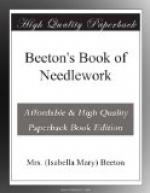The stirrup is made of a loop of ribbon, to which the foundation is tied. Some ladies work a pretty stirrup of the exact shape of a horseman’s stirrup; a loop of ribbon is passed through this, and the foundation fixed as before.
[Illustration 302.—Needle and Mesh.]
303.—To Net.
Place the mesh under the thread, between the thumb and finger of the left hand; it must rest on the middle of the finger and be held only by the thumb (see illustration No. 303). Take the needle in the right hand, pass the thread over the middle and ring finger and over the mesh, pass the needle upwards and behind the mesh in the large loop which forms the thread round the fingers, and at the same time through the first stitch or loop of the foundation. Draw the needle out, retaining the loops on the fingers and dropping them off, the little finger being the last to release the thread. As the thread tightens and the knot is firm, the loop on the little finger should be drawn up quickly and smartly. The next stitches are precisely similar, and row upon row is formed in the same manner. Having learnt the stitch, the next task is to make a foundation. Tie a large loop of strong thread on the stirrup ribbon, and net fifty stitches into this loop, then net four or five rows, and the foundation is ready.
[Illustration: 303.—Netting.]
Simple netting as above explained forms diamonds or lozenges. When a piece of netting is finished it is cut off the foundation, and the little ends of thread that held the stitches are drawn out.
304.—Square Netting.
Is done precisely in the same manner as plain netting, only begin from one stitch, then net two stitches into this first, and increase by making two in the last loop of every row. As soon as the right number of stitches is complete diminish exactly in the same way by netting two stitches as one at the end of each row until one stitch alone remains. These squares are used for guipure d’art and for darning on.
305.—Round Netting
Is nearly similar to plain netting. A little difference exists in the way of passing the needle through the stitch; this is shown in No. 305. After having passed the needle through the stitch it is drawn out and passed from above into the loop just made. This stitch is very effective for purses.
[Illustration: 305.—Round Netting.]
306.—Diamond Netting
Is often called “pointed netting,” and is made by netting from one stitch, increasing one stitch at the end of each row, and decreasing in the same way, as described at page 303.
307.—To Net Rounds.
To form a circle, as for a purse, the needle must pass through the first stitch, keeping the last three or four on the mesh and removing this when required by the work.
308.—"English” Netting
Is made as follows:—Net a row of plain netting, begin the second row by netting the second stitch, then net the first; repeat, always passing by one stitch and taking it up.




